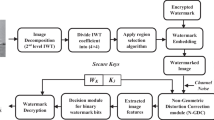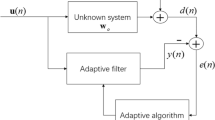Abstract
Nonlinear companding transform (NCT) is an efficient method to reduce the high peak-to-average power ratio (PAPR) of multicarrier transmission systems. However, the introduced companding noise severely restrains the bit-error-rate (BER) performance. In this paper, a general and simple companding noise cancellation (CNC) technique is proposed to mitigate the nonlinear companding noise at the receiver. By exploiting the Bussgang theorem and reconstructing the companding process at the transmitter, the estimated approximate companding noise can be used to refine the received signals. Furthermore, by employing the proposed approach to a typical exponential companding (EC), our results indicate that the proposed scheme can greatly relieve the conventional bottleneck, i.e. the so-called trade-off between the PAPR reduction and BER performance, of NCTs. It shows that for a 512-subcarrier and quadrature phase shift keying modulated orthogonal frequency division multiplexing system, the gap of the signal-to-noise ratio is no more than 0.3 dB at \({P_e} = 1 \times {10^{ - 5}}\) between the ideal performance bound and EC-CNC regardless of the companding degree (\(d=1\) or \(d=2\)) over additive white Gaussian noise channel.






Similar content being viewed by others
Notes
Note that according to [17], this relationship is approximately correct.
If an ideal estimation of \({{\hat{x}}_n}\) is achievable, then, an ideal BER performance can also be achieved without the use of CNC. Furthermore, although some effective coding schemes can reduce the estimate errors of \({{\hat{x}}_n}\), they are in fact at the price of increased complexity or reduced data rate.
Thus, the BER performance in AWGN channel can be viewed as passing through a SSPA with ideal soft limiter.
References
Wunder, G., Fischer, R. F. H., Boche, H., et al. (2013). The PAPR problem in OFDM transmission: New direction for long-lasting problem. IEEE Signal Processing Magazine, 51(11), 130–144.
Correia, L. M., Zeller, D., Blume, O., et al. (2010). Challenges and enableing technologies for energy aware moble radio networks. IEEE Signal Processing Magazine, 48(11), 66–72.
Jiang, T., & Wu, Y. (2008). An overview: Peak-to-average power ratio reduction techniques for OFDM signals. IEEE Transacions on Broadcasting, 54(2), 257–268.
Han, S. H., & Lee, J. H. (2005). An overview of peak-to-average power ratio reduction techniques for multicarrier transmission. IEEE Wireless Communications, 12(2), 56–65.
Zhu, X., Pan, W., Li, H., et al. (2013). Simplified approach to optimized iterative clipping and filtering for PAPR reduction of OFDM signals. IEEE Transactions on Communications, 61(5), 1891–1901.
Wang, Y. C., & Luo, Z. Q. (2011). Optimized iterative clipping and filtering for PAPR reduction of OFDM signals. IEEE Transactions on Communications, 59(1), 33–37.
Guerreiro, J., Dinis, R., & Montezuma, P. (2013). Optimum and sub-optimum receivers for OFDM signals with strong nonlinear distrotion effects. IEEE Transactions on Communications, 61(9), 3830–3840.
Xia, L., Li, Z., Youxi, T., et al. (2008). Analysis of the performance of iterative estimation and cancellation of clipping non-linear distortion in OFDM. In Future generation of communication network (Vol. 2, pp. 193–197).
Chen, H., & Haimovich, A. M. (2003). Iterative estimation and cancellation of clipping noise for OFDM signals. IEEE Communications Letters, 7(7), 305–307.
Slimane, S. B. (2007). Reduction the peak-to-average power ratio of OFDM signals through precoding. IEEE Transactions on Vehicular Technology, 56(2), 686–695.
Qi, X., Li, Y., & Huang, H. (2012). A low complexity PTS scheme based on tree for PAPR reduction. IEEE Communications Letters, 16(9), 1486–1488.
Jiang, T., Ni, C., & Guan, L. (2013). A novel phase offset SLM scheme for PAPR reduction in alamouti MIMO-OFDM systems without side information. IEEE Signal Processing Letters, 20(4), 383–386.
Wang, L., & Tellambura, C. (2008). Analysis of clipping noise and tone-reservation algorithms for peak reduction in OFDM systems. IEEE Transactions on Vehicular Technology, 57(3), 1675–1694.
Gazor, S., & Alihemmati, R. (2012). Tone reservation for OFDM systems by maximizing signal-to-distortion ratio. IEEE Transactions on Wireless Communications, 11(2), 762–770.
Damavandi, M. G., Abbasfar, A., & Michelson, D. G. (2013). Peak power reduction of OFDM systems through tone injection via parametric minimum crosss-entropy method. IEEE Transactions on Vehicular Technology, 62(4), 1838–1843.
Wang, X. B., Tjhung, T. T., & Ng, C. S. (1999). Reduction of peak-to-average power ratio of OFDM system using a companding technique. IEEE Transactions on Broadcasting, 45(3), 303–307.
Jiang, Y. (2010). New companding transform for PAPR reduction in OFDM. IEEE Communications Letters, 14(3), 282–284.
Huang, X., Lu, J., Zhen, J., et al. (2004). Companding transform for reduction in peak-to-average power ratio of OFDM signals. IEEE Transactions on Wireless Communications, 3(6), 2030–2039.
Jiang, T., Yang, Y., & Song, Y. H. (2005). Exponential companding technique for PAPR reduction in OFDM systems. IEEE Transactions on Broadcasting, 51(2), 244–248.
Hou, J., Ge, J., Zhai, D., et al. (2010). Peak-to-average power ratio reduction of OFDM signals with nonlinear companding scheme. IEEE Transactions on Broadcasting, 56(2), 258–262.
Peng, S., Shen, Y., Yuan, Z., et al. (2013). PAPR reduction of LOFDM signals with an efficient nonlinear companding transform. In International conference on wireless communications and signal processing, IEEE WCSP’13 (pp. 1–5).
Wang, Y., Ge, J., Wang, L., et al. (2013). Nonlinear companding transform forreduction of peak-to-average power ratio in OFDM systems. IEEE Transactions on Broadcasting, 59(2), 369–375.
Wang, Y., Wang, L. H., Ge, J. H., et al. (2012). An efficient nonlinear companding transform for reduction PAPR of OFDM signals. IEEE Transctions on Broadcasting, 58(4), 677–684.
Jeng, S. S., & Chen, J. M. (2010). Efficient PAPR reduction in OFDM systems based on a companding technique with trapezium distribution. IEEE Transactions on Broadcasting, 56(2), 258–262.
Peng, S., Shen, Y., & Yuan, Z. (2014). PAPR reduction of multi-carrier systems with simple nonlinear companding transform. IEE Electronics Letters, 50(6), 473–475.
Jiang, T., Yao, W., Song, Y., et al. (2006). Two novel nonlinear companding schemes with iterative receiver to reduce PAPR in multi-carrier modulation systems. IEEE Transactions on Broadcasting, 52(2), 268–273.
Peng, S., Shen, Y., Yuan, Z., et al.(2014). A novel nonlinear companding transform for PAPR reduction in Lattice-OFDM systems. Frequenz, 68(9), 461–468.
Banelli, P., & Cacopardi, S. (2000). Theoretical analysis and performance of OFDM signals in nonlinear AWGN channels. IEEE Transactions on Communications, 48(3), 430–441.
Costa, E., Midrio, M., & Pupolin, S. (1999). Impact of amplifier nonlinearities on OFDM transmission systems performance. IEEE Communications Letters, 3(2), 37–39.
Oestges, C., & Clerckx, B. (2007). MIMO wireless communications: From real-world propagation to space–time code design. San Diego, CA: Academic Press.
Jiang, T., Li, C., & Ni, C. (2013). Effect of PAPR reduction on spectrum and energy efficiencies in OFDM systems with class-A HPA over AWGN channel. IEEE Transactions on Broadcasting, 59(3), 513–519.
Acknowledgements
This work was supported by the National Natural Science Foundation of China (61201242); The Natural Science Foundation of Jiangsu Province (Grant No. BK2012057) and the PLA University Pre-research Foundation (KYTYZLXY1208).
Author information
Authors and Affiliations
Corresponding author
Appendix: Analysis of the BER Performance with HPA over Fading Channel
Appendix: Analysis of the BER Performance with HPA over Fading Channel
Let \({s_n}\) denotes the output after the companded signal \(y_n\) passing through the SSPA, then, \({s_n}\) can be expressed as
where \({w_n}\) is the equivalent noise caused by the SSPA. When transmitted through the fading channel, then, the received signal is
In order to obtain the decided sequence \(\left\{ {{{{\hat{X}}}_k}} \right\} _{k = 0}^{k = N - 1}\), the channel estimation and equalization should be performed before step 1, hence, the equalized signal \(\left\{ {{{{\tilde{r}}}_n}} \right\} _{n = 0}^{n = JN - 1}\) is therefore (assume with ideal channel estimation)
where \({h_n}^{ - 1}\) is the set of tap coefficients of the equalizer.
Since the channel equalization will often enhance the channel noise, thus, the decision errors of \(\left\{ {{{{\hat{X}}}_k}} \right\} _{k = 0}^{k = N - 1}\) will be increased compared with the ideal AWGN channel. After employing the CNC technique at the receiver, the refined channel observation in step 6 is therefore
Different from the ideal AWGN channel with soft limiter or the practical SSPA, in fading channel, the dominant interference will become the component \({w_n} + {h_n}^{ - 1} * {v_n}\) as well as the enhanced estimation error among \(\left( {{d_n} - {{{\hat{d}}}_n}} \right)\), hence, the BER performance improvement for the CNC technique with SSPA over fading channel will not be so optimistic as that in the AWGN channel.
Rights and permissions
About this article
Cite this article
Peng, S., Yuan, Z., You, J. et al. Estimation and Cancellation of Nonlinear Companding Noise for Companded Multicarrier Transmission Systems. Wireless Pers Commun 96, 405–420 (2017). https://doi.org/10.1007/s11277-017-4174-7
Published:
Issue Date:
DOI: https://doi.org/10.1007/s11277-017-4174-7




